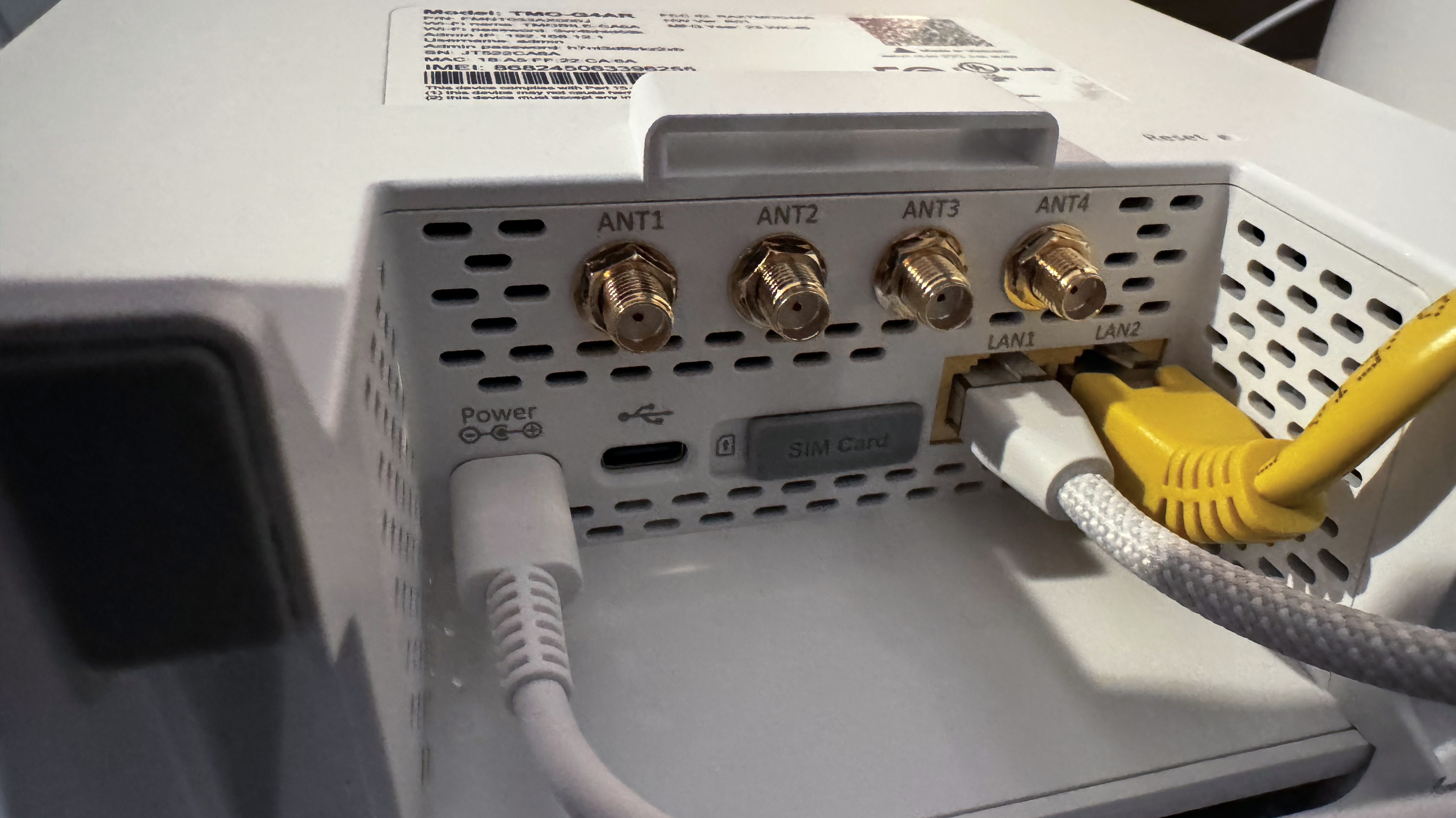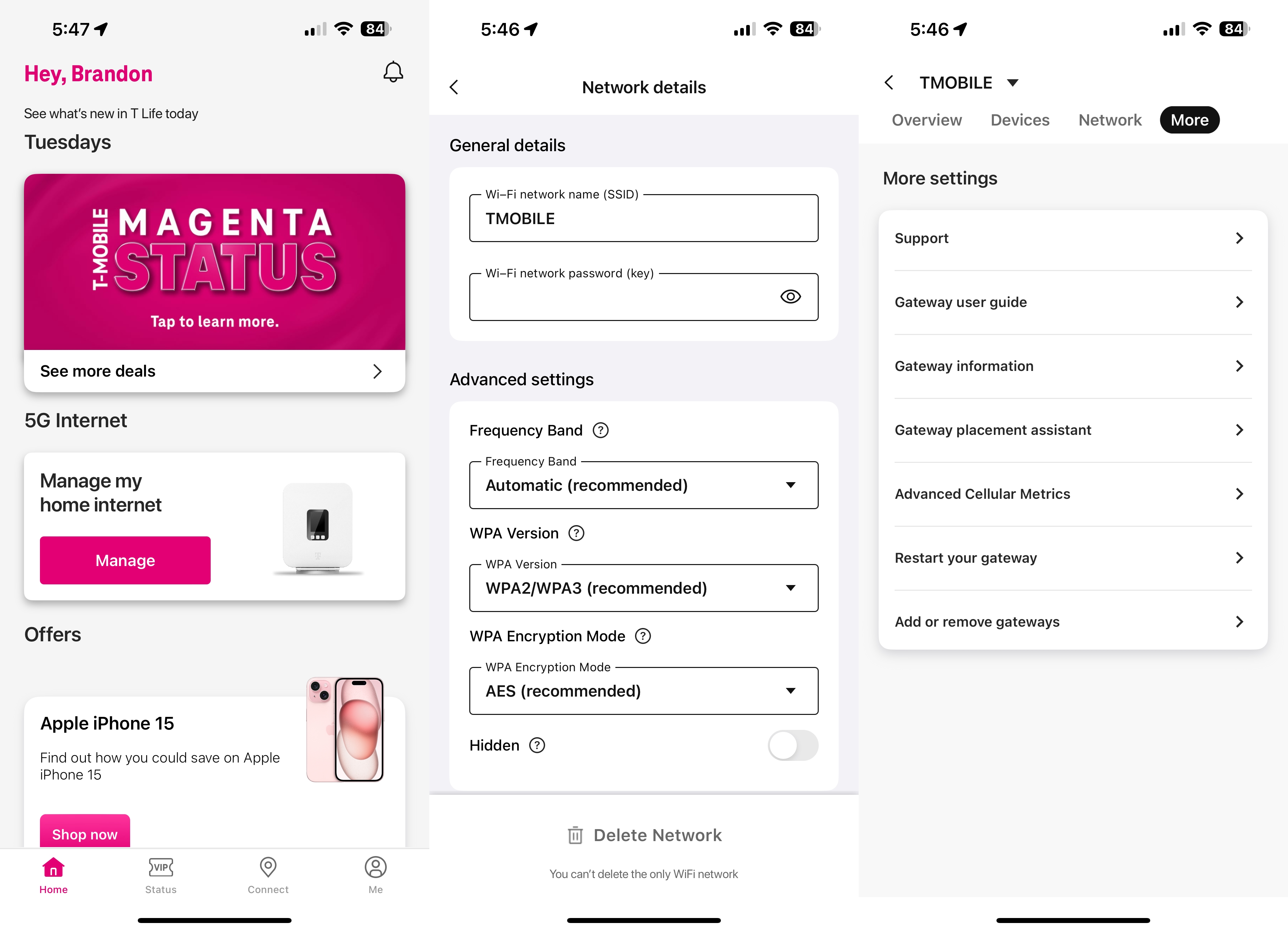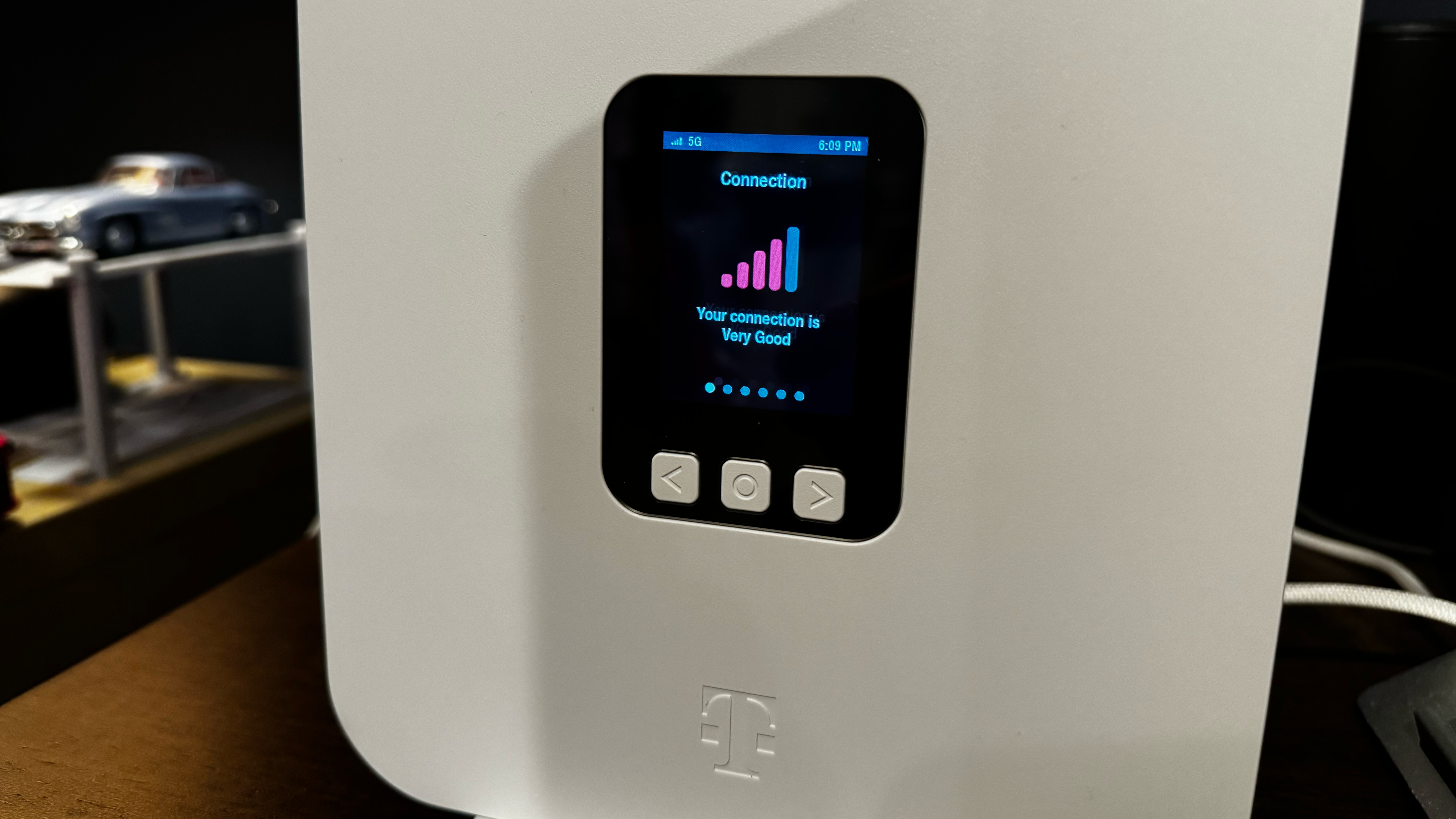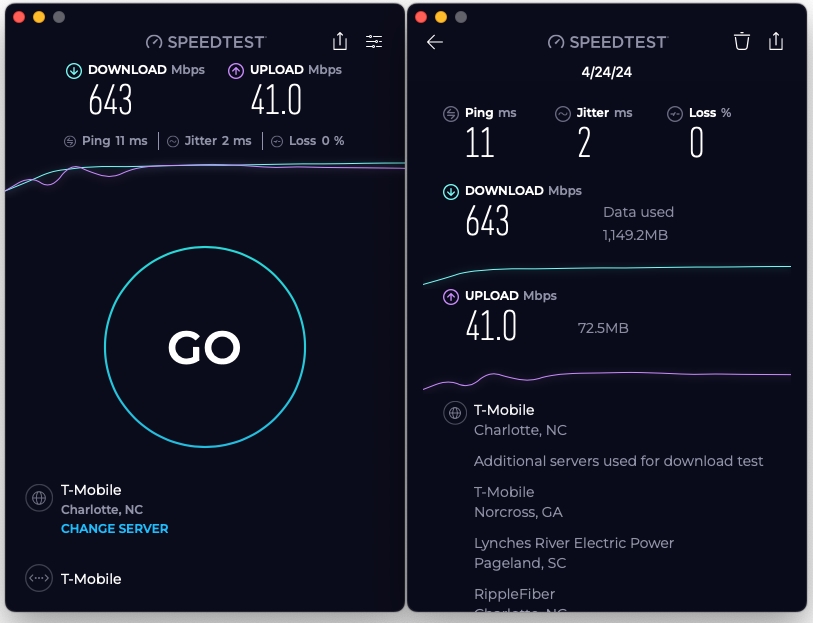T-Mobile Home Internet: Revisiting 5G connectivity for the home after two years
After nearly two years, has T-Mobile Home Internet gotten any better?
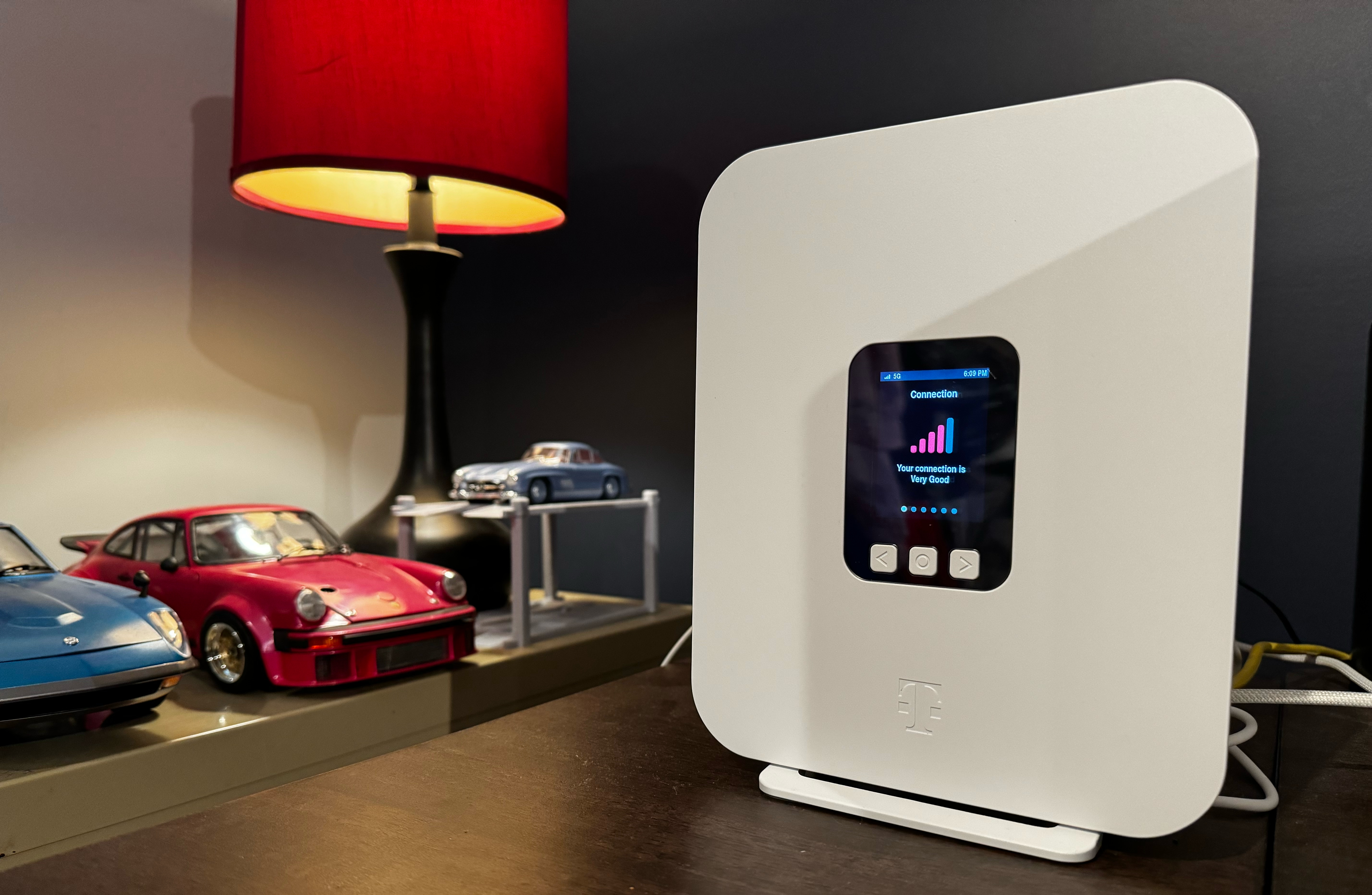
It’s been nearly two years since I wrote a three-part series on my experiences with T-Mobile Home Internet. My first encounter with the service was pleasant enough, as I experienced download speeds of 472 Mbps and upload speeds of 71.9 Mbps. While the downloads were comparable to what I saw with my Spectrum 400/20 cable internet plan, the upload speeds were roughly three times as fast. Better yet, the cost of admission was just $50 per month compared to the $65 per month I was paying for Spectrum internet.
However, things quickly went south two weeks after I initially activated my T-Mobile Home Internet service. I started receiving connection errors, which resulted in losing complete internet connectivity. After two days of no internet and no help from T-Mobile customer service, I crawled back to Spectrum internet, and have been with the service ever since. However, my brief encounter with T-Mobile Home Internet unearthed serious problems with the wireless service, T-Mobile's inability to deal with capacity issues, and customer service representatives that would lie to customers to get them off the phone or kick the can down the road regarding connectivity woes.
Considering significant time has passed since I said goodbye to T-Mobile Home Internet, I decided that now was a good time to revisit the service and see if things have improved.
Returning to T-Mobile Home Internet
Prior to and after my two-week stint with T-Mobile Home Internet, I’ve been using Spectrum’s 400/20 internet plan. The service works fine, and outages are minimal. I can probably count on a single hand how many times I’ve had a significant outage in the past five years. But in the back of my mind, I still couldn’t get past paying $65 a month for 20 Mbps upload speeds.
Last month, I saw a banner ad for T-Mobile Home Internet, which offered a $200 prepaid Mastercard promotion when signing up for its service. Being the cheapskate that I am, the $200 bonus coupled with the still low price of $50 per month with autopay made me decide to give the service another chance… for science. Sidenote: The $50 price is only achieved when you use autopay with a bank draft; otherwise, you pay $55 per month with autopay and a credit card.
Like before, signing up for the service was as easy as logging into my existing T-Mobile account, verifying that I could receive 5G coverage at home, entering my social security number (for a credit check), and confirming my payment details. I placed the order for the service on a Wednesday afternoon, and the welcome package with a 5G gateway arrived on Friday afternoon.
Setting up T-Mobile Home Internet
The old circular 5G gateway that I received in July 2022 is no longer in use. In its place, I received a Sercomm TMO-G4AR that T-Mobile now sends to new customers. The modem/router is a rectangular tower finished in flat white plastic. It has internal antennas for connecting to T-Mobile's 5G/LTE network. However, there are also connectors for attaching an external antenna if you have poor reception.
Get Tom's Hardware's best news and in-depth reviews, straight to your inbox.
There are also two USB-C ports (one of which powers the unit), a SIM card slot, and two GbE ports. I wish there were at least four GbE ports, but I can live with just two.
Getting on the T-Mobile network is as simple as installing the T-Mobile Home Internet (or T-Life) app, scanning the QR code on the back of the device, and following the on-screen prompts. Even though the app told me to set the 5G gateway near a window, I placed it on my desk (where my old Motorola cable modem and Wi-Fi router were positioned) and received four signal bars (out of five).
To expedite the setup process for my plethora of wireless devices (I have over three dozen Wi-Fi devices in my home), I just reused the SSID from my existing wireless router and I was up and running.
The TMO-G4AR functions as a basic Wi-Fi 6 router, which had no trouble covering my two-story home and even outside. However, the big downside to using T-Mobile’s router is that it requires the use of an app to configure the router, and the options available are slim to none. You can change the SSID, network password, and specify frequency bands, but that’s about it. This is geared more toward people who want to set up the router and forget about it, so the in-depth customization that we see with the best Wi-Fi routers is not applicable.
T-Mobile Home Internet Performance
I’ve been using T-Mobile Home Internet with the TMO-G4AR for over a month now. During that billing cycle (March 22 through April 21), I’ve maintained a consistent four bars for signal strength and haven’t experienced any service dropouts. I also haven’t needed to reboot the device for any reason during that time.
Although T-Mobile bills its service as offering “unlimited” internet, the company says that your service may be subject to lower speeds due to data prioritization routines currently in place:
As of January 18, 2024, new T-Mobile Home Internet customers using more than 1.2TB of data in a billing cycle are also considered Heavy Data Users. The threshold number is periodically evaluated across our rate plans and brands to manage network traffic and deliver a good experience to all customers while offering a range of customer choices. You can always check the threshold amount for a rate plan by speaking with a representative, review our rate cards or T-Mobile.com, or by logging in to my.t-mobile.com, or the T-Mobile app.
Even though I used over 1.5TB of data during my first billing cycle, I never noticed any drops in download speeds while using the service. However, I do notice that my upload speeds vary widely depending on the time of the day. As you can see from these SpeedTest results using the app on my Mac, I’m getting downloads in the mid-600 Mbps range—and this is any time during the day. Uploads, however, range from 40 to 60 Mbps.
I haven’t changed my internet usage habits since switching from Spectrum back to T-Mobile Home Internet. That means multiple personal smartphones, tablets, laptops, and desktops are connected. That’s not to mention several test rigs that are always running and TVs that are streaming everything from Sling TV to Disney Plus to Amazon Video. In other words, I just use the service, and it works without issue, which is something I couldn’t truly say after my first two-week stint nearly two years ago.
Final Thoughts
After my nightmare of trying the T-Mobile Home Internet service in 2022, I had no intention of going back to the service. On a whim, I decided to give it another shot and I’ve been impressed by the promise of 5G home internet service. For an entire month, it has been rock solid day in and day out, and just as reliable as my Spectrum internet service. And the cost savings do add up, compared to what I was paying with Spectrum. A $15 savings per month translates into an extra $180 in my bank account. Throw in the $200 prepaid Mastercard that I’ll receive from T-Mobile, and I’d chalk this up as a win, so far.
However, my new “winning” streak with T-Mobile doesn’t discount the troubles I had in the past or troubles that other people had (or continue to have) with the service. Perhaps T-Mobile has upped its capacity to deal with an influx of customers. Maybe its customer support team has improved how it handles customers who call in with problems.
It’s also likely the current generation of 5G gateways is more reliable, thus ensuring that customers have a better internet experience. Or maybe, I just got lucky this time? Who knows for sure, but I’ll just ride this 5G home internet train as long as I can and hope that the experience stays enjoyable.

Brandon Hill is a senior editor at Tom's Hardware. He has written about PC and Mac tech since the late 1990s with bylines at AnandTech, DailyTech, and Hot Hardware. When he is not consuming copious amounts of tech news, he can be found enjoying the NC mountains or the beach with his wife and two sons.
-
brandonjclark I'd probably use one of these services (cellular) as a fail-over ISP, but I can't shake the brain freeze around cellular coverage issues. Again, it's probably just a trust issue, as your article essentially says the the tech might be ready.Reply -
mhcox I've been a T-Mobile 5G Home Internet user for several years now. At first, like you, I had initial "birthing" problems, but things have settled down to a fairly steady 200-400 mbps download and around 100 mbps upload. Unlike you, my download speeds very a lot (as low as middle double digit speeds), but my upload speeds remain fairly constant. Also, there is a lot of variation during the day. During daytime, my speeds slow down noticeably.Reply
Based on the Reddit, Quora, etc. T-Mobile boards, it does seem to be a real lottery winner situation, where you're located determines your performance, although that seems to have died down as a concern. So I think you're right that T-Mobile has beefed up there network to support the home market. -
DavidMV I feel anything than can be wired, should be wired. Save the limited frequency spectrum for mobile users and people that don't have the option for cable/fiber at home.Reply -
bigkazzyry Much like your experience, I too tried T-Mobile home Internet a while back but ultimately went back to Charter due to the inability to access plex and CCTV remotely (CGNAT). I started back with T-Mobile a little less than a month ago and have the same modem as you.Reply
Unfortunately, T-Mobile has gone backwards in giving users control of their Internet experience. This new modem allows almost zero customization, still no port forwarding, still no UPNP, but now they even tightened it down more to where you cannot use your own router; you cannot bypass their router functionality and use the device as a modem.
Fortunately for T-Mobile, a lot of people have been sharing approaches for how to get around CGNAT and due to this, I am sticking with them for the time being. It's not for the faint of heart but those looking to enable plex remote access outside your home, there are a couple options. The one I went with, involves using a free cloud flare account and a domain name I already owned, to create a tunnel to open up remote access.
It shouldn't be this difficult and quite frankly, you should be able to choose how you want to access the Internet and not be tied down to their hardware. I'm holding tight for now, but if other options surface, I may jump from Tmobile once again; especially if they end up slowing my connection down with their 1.2tb soft limit. That's really not difficult to hit when you stream your TV service. -
Math Geek i had considered it at one point but i can get 500/500 Fios for the same $50 a month (ok throw in a few extra for "taxes"). i like the MUCH faster upload speeds and can't imagine only have 10% of that or less available to me on a daily basis.Reply
but an average user who streams video, checks email and spends 50% of their day staring at amazon for more cheap china junk to buy, would never even know the difference if the connection stays solid.
for others with only one option (usually very expensive option), this could be a nice opportunity to move to a better one. i can see plenty of people that would find this a perfectly good option, and i can see many others who would never be happy with it. like me for sure.... -
Alvar "Miles" Udell T-Mobile is also about to start craching down on using your T-Mobile 5G Gateway as a mobile internet device which may impact performance (in a positive way) if you're in a populated area and there are several people who are using it that way.Reply -
ikjadoon Spectrum (and all other cable ISPs) are absolutely being squeezed out by FWA on the low-end and fiber on the high-end. Usually both are cheaper than Spectrum's standard rates, so Spectrum is in a lose-lose situation here.Reply
//
Thus, it makes sense why Spectrum is losing internet customers left and right. On a net basis, in Q1 2024 Spectrum lost 5.5K+ internet customers per week; not a disaster when Spectrum still has 30.5 million internet subscribers, but cable ISPs are finally facing real competition against their 15+ year old DOCSIS 3.0 product.
And it shows:
To keep customers, Spectrum needs to evolve: DOCSIS 3.1 high-split, DOCSIS 4.0), transition (FTTP), or lower prices. And they obviously can, seeing as Spectrum had over half a billion ($576 million) in stock buybacks in 2024 alone. But seems like Spectrum isn't doing it fast enough nor in enough places.
Our home is a little lucky that 2-3 years after an (unreliable) fiber ISP arrived in our neighborhood, Spectrum rolled out high-split DOCSIS 3.1. Now we have 1 Gbps symmetric cable from Spectrum and it's pretty good. File uploads are faster (though few sites have the capacity for 1 Gbps upload per user) and backups are a breeze. No price increase, too (I'd like to see them bloody try).
Still, Spectrum, and the whole cable industry, should've adopted high-split much earlier when DOCSIS 3.1 released; when even a cell phone tower gives better upload speeds than wired cable and it's cheaper, don't expect Spectrum customers to just sit by idly. -
Manxe Kitairn Tried TM Home Internet when it first came out because it had the best presence of all in my area. I experienced the bi-weekly outages, dropped connections, routinely at first. After multiple calls to Support, I discerned the problem was techs working during the day to "improve" the infrastructure. They would take down cell connections without warning to even the Support people, who were not happy. You would think they could use some common sense and repair and replace at O'dark-thirty to avoid inconveniencing customers. But they were Union, and cell phone techs, not used to Datacomms. I went from dropped comms twice a week to once a month before I was able to get Fibre.Reply
But I re-learned lessons from the Navy in the process, recognizing the iffy nature of radio comms. The connection is dependent on distance from the broadcast, the strength of the signal, the antenna at the receiver, and the weather. I found tools online that allowed me to evaluate TMHI signals and test whether the signal would be adequate for TMHI before installation. Using my cell phone and apps from Google Play, I was able to download and use apps that tested current signal strength, and often even provided a mapped image of the tower location. I was not able to change my own TMHI service without selling my house, but my friends and neighbors were happy to benefit from my experiences. Testing for adequate TMHI service evaluation is still possible using Google Play apps on a TM connected phone, and should be performed before you decide to start the TMHI service. Look for LTE Strength Finder, NetMonster, and similar apps to test 4G and 5G signal strength at your location. -
Dezter I had the service for about eight months and had about 3-4 bars of connection. We fully enjoyed it and didn't notice any real drop in service. In April, though, they let us know about the throttling. My wife and I both work at home and stream all of our video services. We go over the 1.2 Tb data cap every month. I called and was assured that since we had the unlimited plan, this did not apply to us.Reply
The next day I received an email where I was told we would be affected by the throttling. I chatted and was told, flat out (I have screen shots of the conversation) that we were lied to the day before and we would absolutely be throttled.
My wife and I are both IT professionals and can't risk being throttled.
I cancelled service and went back to Spectrum...they had a two year offer for a gig line at the same price I was paying for T-Mobile.
I really enjoyed the service and had no complaints at all. If they didn't threaten throttling, I would have gladly stayed.
To T-Mobile's credit, they did refund three months of service because of the customer service lies. -
bobbbobbob My T-Mobile home internet speed has been similar to yours. Sometimes a bit slower in both down speed and up speed, sometimes about 30 or 40% faster both down and up.Reply
Reliability has been absolutely stellar where I live pretty much anywhere I locate the gateway. Wi-Fi coverage in my 1000 ft² lath-and-plaster old apartment has been stellar as well. Max bars everywhere, although I get about 25% more speed if I get close to the gateway with my Samsung S24 Ultra phone.
I have a TV both Wi-Fi connected and cable connected to the gateway. Video performance is great with either, although speedtest.net test speed is pretty terrible on the browser that's on my LG TV. My test generally are about 40 to 50 megabits per second down in about 40 megabits per second up on the TV. Clearly, the TV's overall speed and Wi-Fi performance are pretty bad. But I never get less than clear 4K video resolution on content that is actually available at that resolution.

